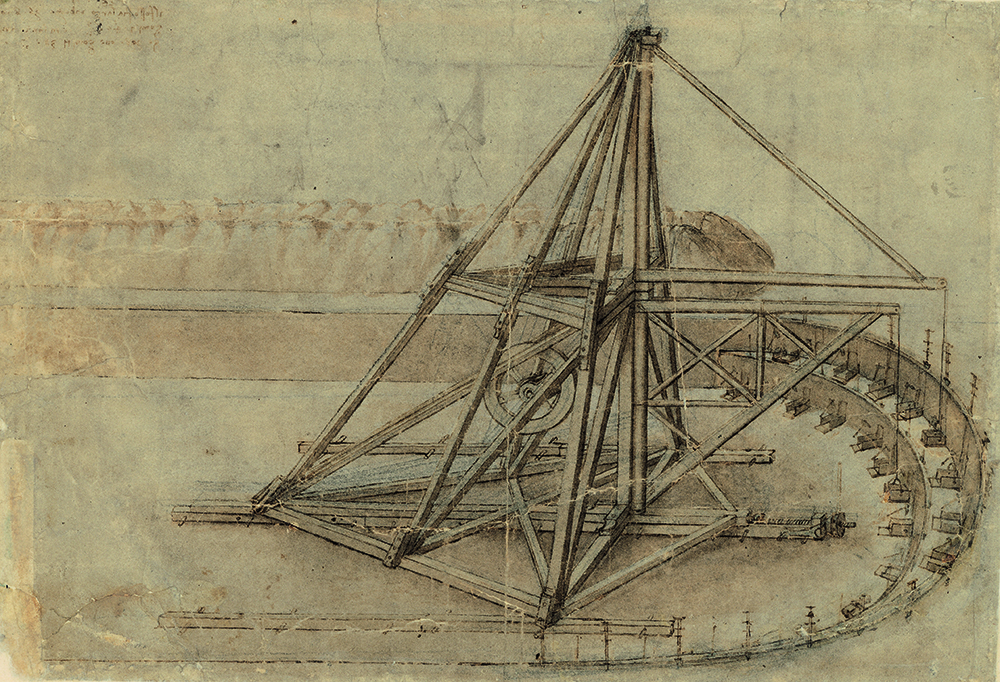Leonardo. Rigorous imagination
Leonardo’s Codex Leicester at the Uffizi. Paolo Galluzzi, curator of the exhibition, tells us about the modernity and passion in these pages
“The page that excited me the most? Perhaps the last one of the Codex, which would actually be the first since Leonardo was left-handed and compiled his notebooks starting from the back. Here Leondardo hypothesizes on the formation of certain mountain chains in the northern hemisphere to compensate for a collapse in the bowels of the Earth which would otherwise have compromised its stability. Naturally this is a hyposthesis, given that he could not see into the bowels of the Earth, but the rigorous rationality with which he arrives at a lucid, and at the same time, almost visionary conclusion is amazing ”.
With these words, Paolo Galluzzi, Director of the Galileo Museum and curator of the exhibition, introduces Leonardo da Vinci’s Codex Leicester. Water, Nature’s Microscope, at the Uffizi until 20 January 2019. Leonardo da Vinci’s Codex Leicester - seventy-two pages of splendid drawings and extraordinary notes on his theories and experiments carried out in the Florence area after almost 20 years spent in Milan – comes back to Florence as a preview of the greatest magnitude of the celebrations that will take place all over the world in 2019 to mark the 500th anniversary of the death of the genius.
It is a gift to the city by Bill Gates, the founder of Microsoft and current owner of the Codex after acquiring it from business tycoon Armand Hammer in 1994. One of the Master’s greatest works, it shows remarkable affinity with our latterly developed awareness regarding the themes of water and the environment, the common thread linking the pages of the manuscript. “There are pages that astonish for their extraordinary modernity. For example, Leonardo speculated that the Moon’s surface was covered in water in order to explain the secondary light produced by the sun’s rays reflecting from the Earth. Indeed, the question of water on planets other than Earth is a matter still widely debated today. That is not all however – Leonardo postulated that the Earth was much older than the 4,000 years attributed to our planet by the Book of Genesis. He deduced this from the presence of marine fossiles found on mountain tops, from which he concluded that the Earth had a history going back to time immemorial. Above all, Leonardo clearly shows that he thinks not only did the creation of the Earth far predate the appearance of Man, but that it was not conceived to satisfy his needs. A daring statement that went against the prevailing Catholic doctrine, but which Leonardo put forward unhesitatingly since his notes were destined to remain in his drawer”
The Codex was conceived for the most part between 1504 and 1508, at a time of intense scientific and artistic activity for Leonardo. They were the years when he studied the anatomy of the human body at the Santa Maria Nuova Hospital, developed the concept of human flight and investigated futuristic solutions for making the Arno navigable. “The Codex was compiled by Leonardo during the most creative phase of his life, in the heart of a Florence which was then a vertible school to the world ” says Paolo Galluzzi.
The pages of the Codex will be on display in the Uffizi’s Aula Magliabechiana, and with the aid of the Codescope, an innovative multimedia device, visitors will be able to “leaf” through the pages of the text on digital screens, read transcriptions and find out much information about the themes explored, while state-of-the-art multimedia equipment will help them understand the pioneering ideas it contains. Thanks to the patronage of Florentine fashion house Stefano Ricci, four pages of the Codex Atlanticus, preserved in the Veneranda Biblioteca Ambrosiana in Milan, will be displayed alongside the Codex Leicester. This invaluable addition to the exhibition consists in two extraordinary civil engineering drawings and two studies of the phases of the Moon, so continuing the main themes of the Codex Leicester. Also on display will be Leonardo’s Codex on the Flight of Birds. Paolo Galluzzi’s answer when asked what we learn to love about the Florentine genius by leafing through his codexes is unreserved: “His curiosity, the passion that led him to continuously open parentheses that he almost always forgot to close, fascinated by the new areas of exploration they opened up. The result was the many studies left uncompleted, but also the magnificent insights that leave us astonished”.









